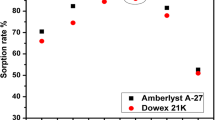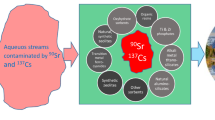Abstract
Various uranyl sulfate complexes are formed during the digestion of monazite mineral by sulfuric acid. Uranyl sulfate sorption by AMBERJET 4200 Cl has been studied to find out the proper mechanism, equilibrium and kinetics basis. At pH of 3.0 and 0.5 M SO4 − the dominant solution species of U(VI) is [UO2(SO4)3]−4 anionic complex. High sorbent affinity and monolayer sorption mechanism are approved by different isotherms. The rate is found to be controlled by surface adsorption and intra-particle diffusion. The equilibrium equation and kinetic parameters are estimated. The thermodynamic studies reveal that the reaction is endothermic and spontaneous.










Similar content being viewed by others
References
Yusan S, Akyil S (2008) Sorption of uranium (VI) from aqueous solutions by akaganeite. J Hazard Mater 160:388–395
Krestou A, Xenidis A, Panias D (2004) Mechanism of aqueous uranium (VI) uptake by hydroxyapatite. Miner Eng 17:373–381
Michard P, Guibal E, Vincent T, Le Cloirec P (1996) Sorption and desorption of uranyl ions by silica gel: pH, particle size and porosity effects. Microporous Mater 5:309–324
Tsuruta T (2002) Removal and recovery of uranyl ion using various microorganisms. J Biosci Bioeng 94:23–28
Kulkarni PS (2003) Recovery of uranium (VI) from acidic wastes using tri-n-octylphosphine oxide and sodium carbonate based liquid membranes. Chem Eng J 92:209–214
Chaudhury S, Singh Mudher KD, Venugopal V (2003) Recovery of uranium from fluoride matrix by solid state reaction routes. J Nucl Mater 322:119–125
Amamoto I, Terai T, Oobayashi H, Fujit R (2005) Separation and recovery study of uranium from spent NaF (fillers). J Phys Chem Solids 66:602–607
Mirjalili K, Roshani M (2007) Resin-in-pulp method for uranium recovery from leached pulp of low grade uranium ore. Hydrometallurgy 85:103–109
James D, Venkateswaran G, PrasadaRao T (2009) Removal of uranium from mining industry feed simulant solutions using trapped amidoxime functionality within a mesoporous imprinted polymer material. Microporous Mesoporous Mater 119:165–170
Akhtar K, Khalid AM, Akhtar MW, Ghauri MA (2009) Removal and recovery of uranium from aqueous solutions by Ca-alginate immobilized trichodermaharzianum. Bioresour Technol 100:4551–4558
Singh SK, Dhami PS, Tripathi SC, Dakshinamoorthy A (2009) Studies on the recovery of uranium from phosphoric acid medium using synergistic mixture of (2-Ethyl hexyl) Phosphonic acid, mono (2-ethyl hexyl) ester (PC88A) and Tri-nbutyl phosphate (TBP). Hydrometallurgy 95:170–174
Zhang Z, Clifford DA (1994) Exhausting and regenerating resin for uranium removal. J Am Water Works Assoc 86:228–241
Song Y, Wang Y, Wang L, Song C, Yang ZZ, Zhao A (1999) Recovery of uranium from carbonate solutions using strongly basicanion exchanger. React Funct Polym 39:245–252
Huikuri P, Salonen L (2000) Removal of uranium from Finnish ground waters in domestic use with a strong base anion resin. J Radioanal Nucl Chem 245:385–393
Chellam S, Clifford DA (2002) Physical–chemical treatment of groundwater contamined by leachate from surface disposal of uranium tailings. J Environ Eng 128:942–952
Sheta ME, Kandil AT, Abd El-Aal MM (2012) Eleventh Arab Conference on the peaceful Use of Atomic Energy, Khartoum Sudan, 16–20 December
Rabie KA, Abd El-Moneam YK, Abd El-Fatah AI, Demerdash M, Salem AR (2014) Adaptation of anion exchange process to decontaminate monazite rare earth group from its uranium content. IJRET: 2321–7308
Kouraim MN, Sheta ME, Abd El-Aal MM (2014) Investigation of uranium sorption from acidic sulfate solution using organosilicate compound and Amberlite IRA 402. Eur J Chem 5:446–450
Navratil JD (1989) Ion exchange technology in spent fuel reprocessing. J Nucl Sci Technol 26:735–743
Ladeira Ana CQ, Morais CA (2005) Effect of ammonium, carbonate and fluoride concentration on the uranium recovery by resins. Radiochim Acta 93:207–209
Gott MD, Ballard BD, Redman LN, Maassen JR, Taylor WA, Engle JW, Nortier FM, Birnbaum ER, John KD, Wilbur DS, Cutler CS, Ketring AR, Jurisson SS, Fassbender ME (2014) Radiochemical study of re/w adsorption behavior on a strongly basic anion exchange resin. Radiochim Acta 102:325–332
Marczenko Z (1986) Separation and spectrophotometric determination of elements. Ellis Harwood, Chichester
Sheha RR, El-Zahhar AA (2008) Synthesis of some ferromagnetic composite resins and their metal removal characteristics in aqueous solutions. J Hazard Mater 795–803:150
Sheha RR (2007) Sorption of Zn (II) ions on synthesized hydroxyapatites. J Colloid Interface Sci 310:18–26
Guillaumont R, Fanghänel T, Neck V, Fuger J, Palmer DR, Grenthe I, Rand MH (2003) Chemical thermodynamics 5, 5th edn. Elsevier, Heidelberg
Sakaguchi T, Nakajima A (1987) Accumulation of uranium by biopigments. J Chem Technol Biotechnol 40:133–141
Aslani MAA, Eral M (1994) Investigation of uranium recovery from dilute aqueous solutions using silk fibroin. Biol Trace Elem Res 737:737–743
Boonamnuayvitaya V, Chaiya C, Tanthapanichakoon W, Jarudilokkul S (2004) Removal of heavy metals by adsorbents prepared from pyrolyzed coffee residues and clay. Sep Purif Technol 35:11–22
Huh JK, Song DI, Jeon YW (2000) Sorption of phenol and alkylphenols from aqueous solution onto organically modified montmorillonite and applications of dual-mode sorption model. Sep Sci Technol 35:243–259
Lagergren S (1898) About the theory of so called adsorption of soluble substances. Kung Sven Veten Hand 24:1–39
Freundlich H (1906) Uber die adsorption in losungen (Adsorption in solution). Z Phys Chem 57:387–470
Justi KC, Fávere VT, Laranjeira MCM, Neves A, Peralta RA (2005) Kinetics and equilibrium adsorption of Cu(II), Cd (II), and Ni(II) ions by chitosan functionalized with 2[-bis-(pyridylmethyl)aminomethyl]-4-methyl-6-formylphenol. J Colloid Interface Sci 291:369–374
Ho YS, McKay G (1999) Pseudo-second order model for sorption processes. Process Biochem 34:451–465
Kobiraj R, Gupta N, Kushwaha AK, Chattopadhyaya MC (2012) Determination of equilibrium, kinetic and thermodynamic parameters for the adsorption of Brilliant Green dye from aqueous solutions onto eggshell powder. Indian J Chem Technol 19:26–31
Hameed BH, Ahmad AA, Aziz N (2007) Isotherms, kinetics and thermodynamics of acid dye adsorption on activated palm ash. Chem Eng J 133:195–203
Glasston S, Laidler KJ, Eyring H (1941) The theory of rate processes. McGraw Hill, New York
Wu FC, Tseng RL, Juang RS (2001) Kinetic modeling of liquid-phase adsorption of reactive dyes and metal ions on chitosan. Water Res 35:613–618
Cooney DO (1998) Adsorption design for wastewater treatment. CRC Press, Boca Raton
Moulin JP, Pareau D, Rakib M, Stambouli M(2004) Transfert de matière, autresopérationscompartimentées. Techniques de l’ingenieur, Génie des Procédés, J1073, Paris, France
Othman SH, Ali AH, Mansour NA, El Anadouli BE (2012) The effect of external and internal diffusion on the sorption of radioactive ions by reactive cloth filter—part I. J Radioanal Nucl Chem 291:685–698
Othman SH, Saleh MM, Demerdash M, El Anadouli BE (2010) Mathematical model: retention of beryllium on flow-through fixed bed reactor of Amb-IR-120. J Chem Eng 156:157–164
Ali AH, Othman SH (2011) A physico-chemical parametric study on the retention of radioactive ions in a fixed bed reactor. Chem Eng J 178:375–383
Author information
Authors and Affiliations
Corresponding author
Rights and permissions
About this article
Cite this article
Othman, S.H., Ezz Eldin, A.A., Borai, E.H. et al. Speciation modeling and sorption mechanism for decontamination of naturally occurring radionuclide from sulfuric acid liquor by anion exchange process. J Radioanal Nucl Chem 314, 1063–1073 (2017). https://doi.org/10.1007/s10967-017-5463-z
Received:
Published:
Issue Date:
DOI: https://doi.org/10.1007/s10967-017-5463-z




